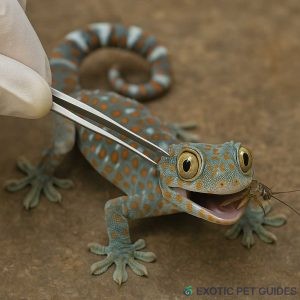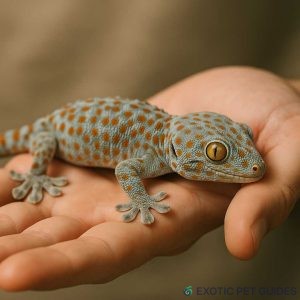🧭 Introduction
Tokay Geckos (Gekko gecko) are known for two things:
- Their beautiful colors
- Their intense attitude
They are notorious biters, and many first-time owners are surprised by their aggression. But the truth is — their behavior is defensive, not malicious.
This article explores:
- Why Tokay Geckos bite
- Signs of stress or fear
- How to reduce biting risk
- Safe handling strategies

😡 Why Tokay Geckos Bite
1. Territorial Instincts
Tokays are highly territorial and may see your hand as an intruder.
They don’t trust easily and don’t like being grabbed from above.
⚠️ In the wild, they defend tree hollows and rock crevices — they do the same in captivity.
2. Fear Response
Sudden movement = predator alert.
If they feel cornered, their first response is to bite.
- Moving too fast?
- Loud noises?
- Removing hide suddenly?
Expect a defensive reaction.
3. Wild-Caught (WC) vs Captive-Bred (CB)
Most aggressive Tokays are wild-caught.
| Source | Behavior |
|---|---|
| Wild-caught | Nervous, aggressive, high stress |
| Captive-bred | More tolerant, less reactive |
Tip: Ask your breeder if your gecko is WC or CB.

🧠 Signs of an Aggressive or Stressed Tokay
- Gaping mouth
- Loud clicking or barking
- Tail twitching or curling upward
- Lunging or hissing
- Frozen posture, wide eyes

🛑 How to Avoid Getting Bitten
🧤 1. Don’t Handle at First
Let your gecko settle for 2–3 weeks after arrival.
Handle the enclosure — not the gecko.
🐢 2. Move Slowly
Use slow, sideways movements, not overhead grabs.
Approach from the side — geckos are ambush hunters and react poorly to “predator-style” movements.
🧰 3. Use Tools
Use:
- Feeding tongs
- Snake hook
- Padded reptile gloves
Never reach in with bare hands if your Tokay is displaying stress signs.

🎧 4. Minimize Noise
Keep tank in a quiet location, especially during daytime sleep hours.
Avoid banging, loud TV, or heavy foot traffic.
🤝 Can Tokay Geckos Be Tamed?
Yes — but not all of them.
Some captive-bred Tokays become tame enough to:
- Take food from hands
- Walk onto your palm
- Climb around your arms
Others may never accept handling, but still thrive as display pets.
Success depends on patience, consistency, and your gecko’s unique personality.

📋 Safety Gear Checklist
✅ Thick gloves
✅ Feeding tongs
✅ Snake hook
✅ Transparent plastic hide for catch/cup
✅ First-aid antiseptic in case of bite (optional)

🧼 What to Do If You Get Bitten
- Don’t yank your hand back — you’ll tear your skin
- Gently place the gecko down on a surface to make it release
- Clean the bite with soap + antiseptic
- Monitor for infection (rare)
🩹 Most bites aren’t dangerous, just painful and surprising.
✅ Pros & Cons Summary
Pros of Understanding Behavior
✔ Lower stress for you and the gecko
✔ Safer feeding and tank maintenance
✔ Builds trust over time
Cons of Mishandling
✘ Painful bites
✘ Fear response from gecko
✘ Difficult long-term bonding